I do fancy all kinds of aquarium mosses. They don’t re quire any special care, grow at a leisurely pace, they are rather appealing and make any tank look really natural. However, for almost all my life I’ve dealt with only one type of moss – Java moss. But recently I had to start a new tank and plant several different kinds of mosses there. So, I had a chance to study mosses available on the market in details, to organize the information obtained and then I decided to write about what I know now. Here is what I’ve came up with.
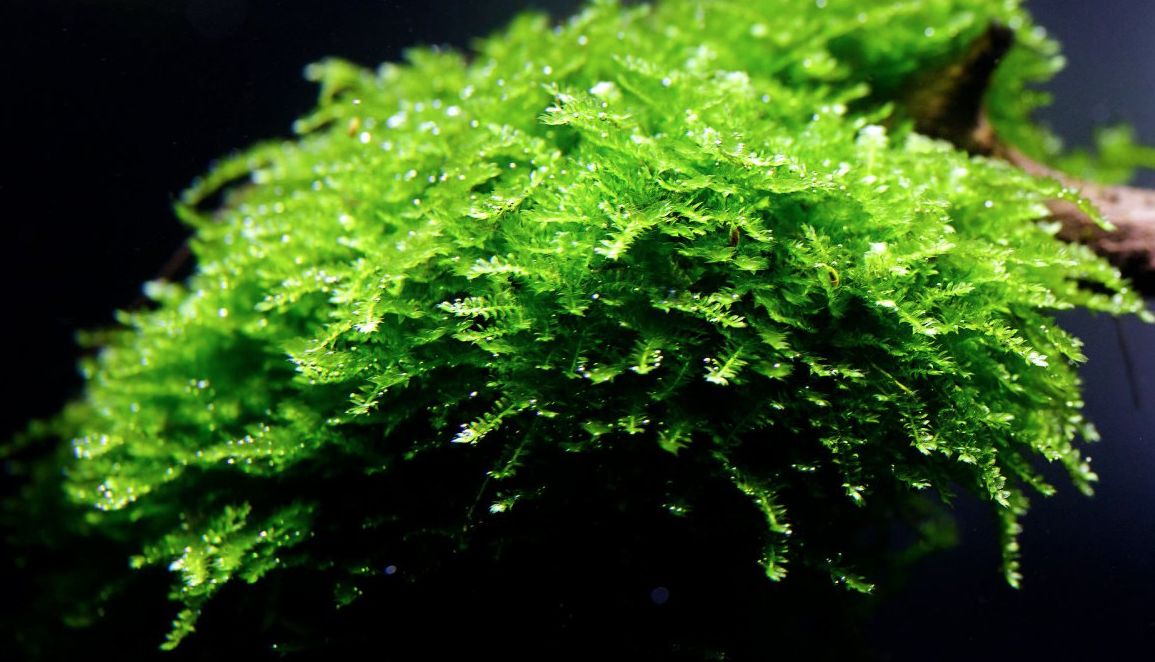
Contents
- 1 Mosses in nature
- 2 How can you benefit from using mosses in a tank
- 3 Popular types of moss for aquarium
- 3.1 Java moss (Taxiphyllum barbieri)
- 3.2 Flame Moss (Taxiphyllum sp. ‘Flame’)
- 3.3 Weeping Moss (Vesicularia Ferriei)
- 3.4 Phoenix moss (Fissidens fontanus)
- 3.5 Christmas moss (Vesicularia montagnei)
- 3.6 Subwassertang (Lomariopsis Lineata)
- 3.7 Riccia fluitans
- 3.8 Willow moss (Fontinalis antipyretica)
- 3.9 Taiwan Moss (Taxiphyllum alternans)
- 3.10 Spiky Moss (Taxiphyllum sp ‘Spiky Moss’)
- 3.11 Riccardia chamedryfolia
- 4 Keeping in a tank
- 5 Care
- 6 Friends of aquarium mosses
- 7 Enemies of aquarium mosses
- 8 Decorations and how to attach moss
Mosses in nature
Mosses are the most ancient plants on our planet. Nowadays, about 10000 of species have been defined; they have been joined into about 700 geniuses and 110-120 families. As a rule, these are small terrestrial plants. Aquatic mosses are the only exception and this is what we are going to talk about in our guide.
Classification of mosses is based on such features as appearance, presence of leaf veins, type of the leaf edge, differentiation of cells in the leaf base, shape of the stem (cylindrical or flattened), type of the stem branching, presence of rhizoids and spore cases.
Most of these features can’t be defined without using a microscope, photos to perform comparison and having some certain background in this area is a must as well.
Another thing is that mosses appearance may vary greatly depending on their living environment. Like many other tank plants aquarium mosses change their shape, branching type and leaf shape if they grow under water.
Many commercial names of mosses still don’t have any Latin genus name.
How can you benefit from using mosses in a tank
- They are easy to keep, they adapt to many various tank conditions
- Slow pace of growth
- Make your tank look natural
- You can use them in a tank of any size and volume
- They don’t have any roots, so you can move them together with the substrate
- Provide safety to fish juveniles as well as it is an ideal place for fish spawning
- This is a shelter and a house for shrimps and their offspring
- There are many kinds of mosses and all of them are very different
Popular types of moss for aquarium
Let me say, that it’s extremely challenging to describe all the kinds. First of all, because lots of many different moss kinds have appeared recently. Most of them have several commercial names, which makes the task even more difficult. Due to the above mentioned there may be some inaccuracies in the guide, which we’ll surely correct in time.
Java moss (Taxiphyllum barbieri)
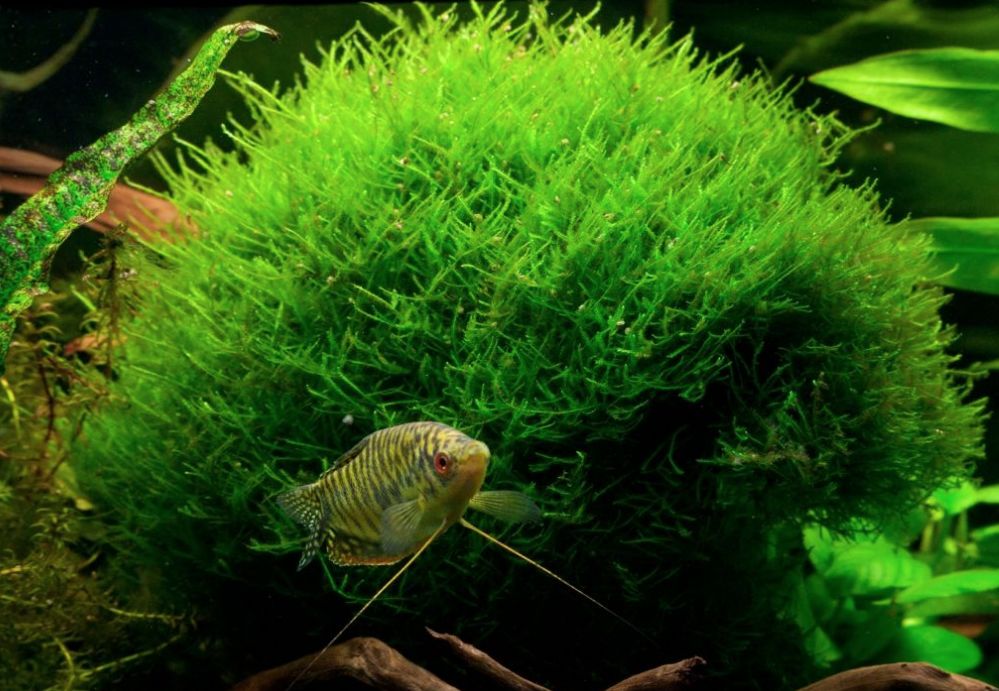
Java moss is the most widespread and renowned aquarium moss. It has gained its popularity due to its appealing appearance, endurance and unpretentiousness.
To keep Java moss in your tanks it is enough just to attach small pieces of the moss where you would like it to grow. Besides, you can also make it grow on a substrate. Due to its small brownish roots the moss sticks to the surface where it is put. Java moss uses vegetative reproduction by cutting a parent moss bush into pieces.
It can be easily cut and planted all over the tank. Such a simple way of growing is an advantage for sure, but sometimes some pieces of the moss that are left after cutting may grow somewhere as well, which isn’t always what the tank owner needs.
In general, Java moss is extremely popular for a good reason. It combines main values of any aquarium plant: appealing look, unpretentiousness and it is easy to grow.
| Aspect | Description |
|---|---|
| Scientific Name | Taxiphyllum barbieri |
| Appearance | Small, delicate moss with branching stems and tiny, pointy leaves |
| Growth Rate | Slow to moderate growth rate, suitable for low-tech setups |
| Light Requirements | Can tolerate low to moderate lighting conditions, but thrives under medium to high light |
| CO2 Requirement | Can thrive without CO2 supplementation, but benefits from CO2 injection for faster and denser growth |
| Water Parameters | Temperature: 68-82°F (20-28°C); pH: 5.0-8.0; soft to moderately hard water |
| Attachment | Attaches to various surfaces like rocks, driftwood, and aquarium decorations |
| Maintenance Level | Low-maintenance plant; requires occasional trimming to prevent overgrowth |
| Propagation Methods | Easily propagated by cutting and reattaching stems or removing portions of the moss |
| Versatility | Suitable for aquariums, terrariums, and paludariums; provides hiding spots for small aquatic species |
| Benefits | Enhances water quality by absorbing excess nutrients and providing shelter for fry and small fish |
| Common Uses | Aquascaping, creating moss walls, attaching to rocks and driftwood for natural-looking setups |
Flame Moss (Taxiphyllum sp. ‘Flame’)
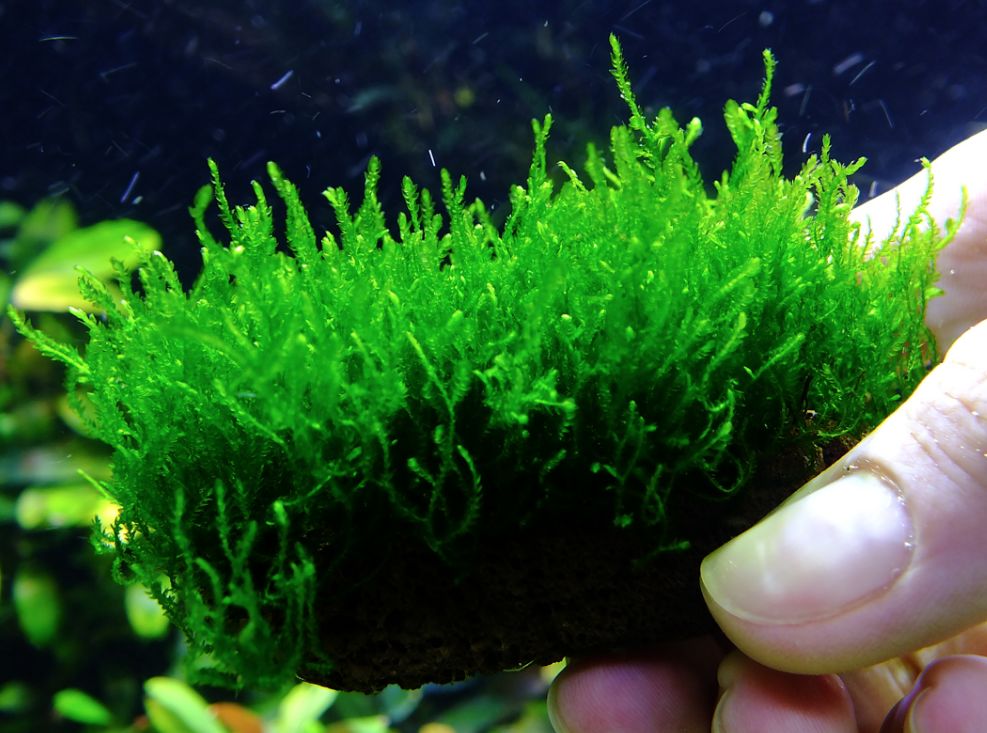
Flame moss is a moss species that grows in Asia. The plant got its name due to its appearance, which resembles spurts of flame. Unlike other moss kinds Flame moss grows upwards much faster than widthway. When growing it forms ornamental bushes that look rather nice together with other tank plants.
Besides, the plant can maintain its decorative appearance for a long time and at that it doesn’t require any special care. After you put the plant on the new place, it requires a short adaptation period (not more than 2 weeks) and then it starts to grow actively and in a rather short time a new bush of the moss will be formed.
It is desirable to put the new plant into a tank with old water, this way the adaptation period will take less time. Besides, in fresh water or in a tank that was just started the moss usually gets ill and quite often dies.
Comfortable tank water parameters for Flame moss are the following: water temperature 20-28°C, harness dH от 4 до 9°, acidity pH from 6 to 7,5. The way how the moss leaves are twisted depends on the water hardness. Additional CO2 supply is desirable to increase the moss growth rate as well as slight water flow in a tank.
Flame moss grows on any substrate, the main thing is that the latter is not too silty. You may obtain quite an unusual effect when planting Flame moss on various decorations (snags and stones).
| Aspect | Description |
|---|---|
| Scientific Name | Taxiphyllum sp. ‘Flame’ |
| Appearance | Feathery, vibrant green moss with upright growth resembling flames |
| Growth Rate | Slow growth rate, suitable for low-tech setups |
| Light Requirements | Thrives under medium to high lighting conditions |
| CO2 Requirement | Can grow well without CO2 supplementation, but benefits from CO2 injection for faster growth |
| Water Parameters | Temperature: 68-82°F (20-28°C); pH: 5.0-8.0; soft to moderately hard water |
| Attachment | Attaches to various surfaces like rocks, driftwood, and aquarium decorations |
| Maintenance Level | Low-maintenance plant; occasional trimming to maintain shape and prevent overgrowth |
| Propagation Methods | Easily propagated by cutting and reattaching sections of the moss |
| Versatility | Suitable for aquariums, terrariums, and paludariums; provides hiding spots for small aquatic species |
| Benefits | Enhances water quality by absorbing excess nutrients and provides shelter for fry and small fish |
| Common Uses | Aquascaping, creating moss walls, attaching to hardscape for a unique and striking appearance |
Weeping Moss (Vesicularia Ferriei)
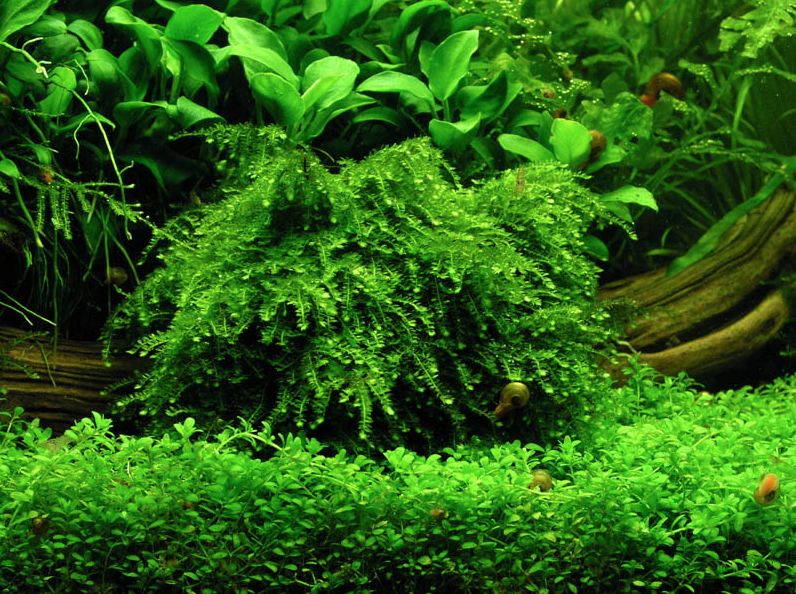
Weeping moss is from China and initially it was used by Chinese aquarists. It grows up to 3 cm high, width of the moss bush is 5 cm; it has bright-green hanging shoots that resemble branches of weeping willow due to which it got its name. Growth pace of Weeping moss is a medium one.
Weeping moss leaves shape partly resemble the one of Christmas moss. However, Weeping moss leaves are twice smaller and they don’t get abruptly narrow.
Comfortable water parameters are the following: water temperature from 22 to 28°C, pH from 5,5 to 8, KH from 6 to 14°. Weeping moss stands even higher temperature (up to 32°C) without loosing its incredible appearance, though its branches may get yellow.
CO2 supply stimulates its growth and improves the moss appearance. Weeping moss can stand living in both low and high illuminated tanks. It is important to maintain optimal level of oxygen and other nutrients in a tank.
Any disproportion of nutrients provokes appearance of algae on the moss. Weeping moss is often attached to snags and its hanging shoots create perspective and contrast in the tank. Sea-line or caprone thread are used to attach the moss.
After you finish decorating the tank with moss, be patient – the plant requires several days for adaptation. It is quite possible that very soon you will be already cutting it.
| Aspect | Description |
|---|---|
| Scientific Name | Vesicularia ferriei |
| Appearance | Long, slender strands with drooping branches resembling a weeping willow |
| Growth Rate | Moderate growth rate, suitable for low to high-tech setups |
| Light Requirements | Thrives under moderate to high lighting conditions |
| CO2 Requirement | Can grow well without CO2 supplementation, but benefits from CO2 injection for faster growth |
| Water Parameters | Temperature: 68-82°F (20-28°C); pH: 5.0-8.0; soft to moderately hard water |
| Attachment | Attaches to various surfaces like rocks, driftwood, and aquarium decorations |
| Maintenance Level | Low-maintenance plant; occasional trimming to maintain shape and prevent overgrowth |
| Propagation Methods | Easily propagated by cutting and reattaching sections of the moss |
| Versatility | Suitable for aquariums, terrariums, and paludariums; provides hiding spots for small aquatic species |
| Benefits | Enhances water quality by absorbing excess nutrients and provides shelter for fry and small fish |
| Common Uses | Aquascaping, creating a natural and flowing appearance, attaching to hardscape for a unique look |
Phoenix moss (Fissidens fontanus)
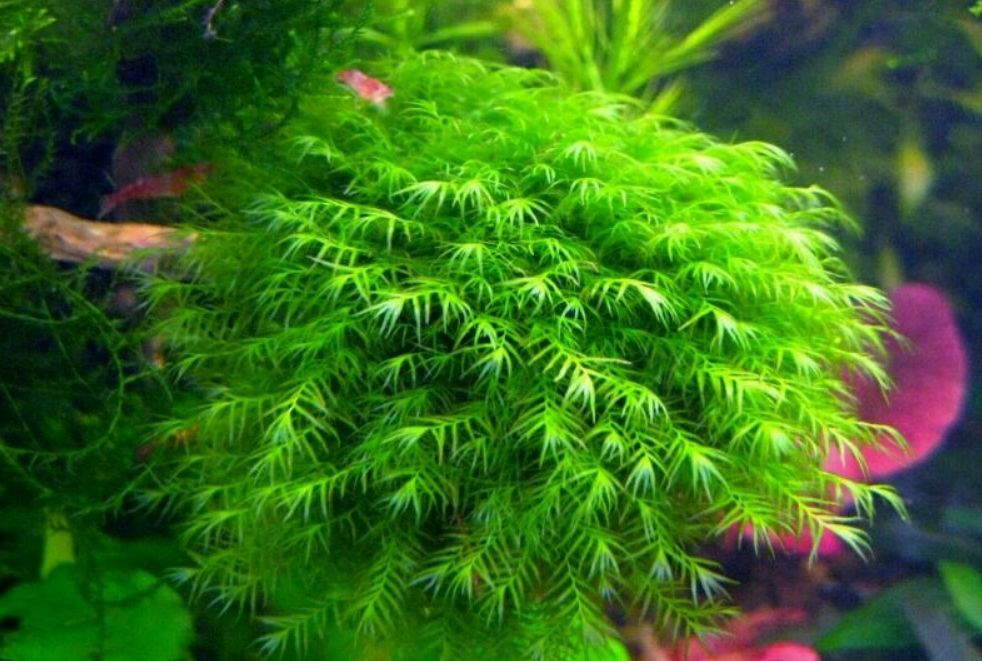
In the wild Phoenix moss grows in waters of North America. This moss has a shape of a hillock or a fountain (the latter gave it its Latin name). Due to its high growth pace and the fact that it is easy to keep, it can be recommended even for beginners.
Phoenix moss is also used as a ground-covering plant, its shoots hang rather nicely from snags and stones and resemble a green fountain. To make the moss grow on decorations, it is enough to tie several moss shoots with a cotton thread where you need them to be. The thread will rot, but by this time Phoenix moss will tightly stick to the object.
This moss is undemanding, grows at temperature range from 15 to 28°C (59-82°F), however, when the temperature reaches extreme values its growth rate sufficiently decreases. You can increase it by adding direct intense lighting and CO2 supply into the tank.
The plant prefers soft water with pH from 5,5 to 8. When decorating the tank with Phoenix moss it’s desirable to put it in the center, not in the tank corners.
| Aspect | Description |
|---|---|
| Scientific Name | Fissidens fontanus |
| Appearance | Feather-like moss with dense branching and delicate, elongated leaves |
| Growth Rate | Slow to moderate growth rate, suitable for low to high-tech setups |
| Light Requirements | Thrives under moderate to high lighting conditions |
| CO2 Requirement | Can grow well without CO2 supplementation, but benefits from CO2 injection for faster growth |
| Water Parameters | Temperature: 68-82°F (20-28°C); pH: 5.5-8.0; soft to moderately hard water |
| Attachment | Attaches to various surfaces like rocks, driftwood, and aquarium decorations |
| Maintenance Level | Low-maintenance plant; occasional trimming to maintain shape and prevent overgrowth |
| Propagation Methods | Easily propagated by cutting and reattaching sections of the moss |
| Versatility | Suitable for aquariums, terrariums, and paludariums; provides hiding spots for small aquatic species |
| Benefits | Enhances water quality by absorbing excess nutrients and provides shelter for fry and small fish |
| Common Uses | Aquascaping, creating a natural and forest-like appearance, attaching to hardscape for a unique look |
Christmas moss (Vesicularia montagnei)
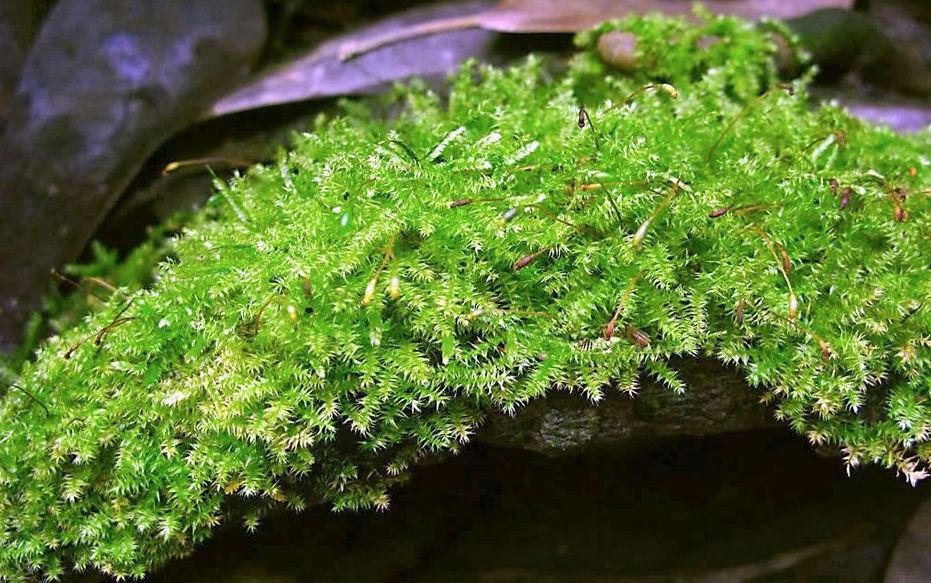
Christmas moss got its name due to its leaves shape that resembles fir-tree branches. Though this isn’t the only moss kind which outline resembles needle-leaved trees.
Christmas moss successfully sticks to snags and stones, it stays in the substrate longer than others and easily stands cutting process. Its appearance and growth rate depends on its living environment: provided with scattered lighting the moss will grow slower and its structure won’t resemble a fir-tree; at bright lighting the moss bush becomes rather thick.
Comfortable water parameters for this moss are the following: water temperature from 24 to 26°C (75-78°F); pH from 5 to 8.
Lighting range may vary from low to bright, however, at intensive light you will soon see thread algae in the moss and sometimes it is quite challenging to get rid of it. Information if CO2 supply is helpful for Christmas moss is rather controversial; it is unlikely to influence the moss growth rate essentially.
| Aspect | Description |
|---|---|
| Scientific Name | Vesicularia montagnei |
| Appearance | Soft, bushy moss with triangular, slightly curved leaves resembling a Christmas tree |
| Growth Rate | Slow to moderate growth rate, suitable for low to high-tech setups |
| Light Requirements | Thrives under moderate to high lighting conditions |
| CO2 Requirement | Can grow well without CO2 supplementation, but benefits from CO2 injection for faster growth |
| Water Parameters | Temperature: 68-82°F (20-28°C); pH: 5.0-8.0; soft to moderately hard water |
| Attachment | Attaches to various surfaces like rocks, driftwood, and aquarium decorations |
| Maintenance Level | Low-maintenance plant; occasional trimming to maintain shape and prevent overgrowth |
| Propagation Methods | Easily propagated by cutting and reattaching sections of the moss |
| Versatility | Suitable for aquariums, terrariums, and paludariums; provides hiding spots for small aquatic species |
| Benefits | Enhances water quality by absorbing excess nutrients and provides shelter for fry and small fish |
| Common Uses | Aquascaping, creating a natural and festive appearance, attaching to hardscape for a unique look |
Subwassertang (Lomariopsis Lineata)
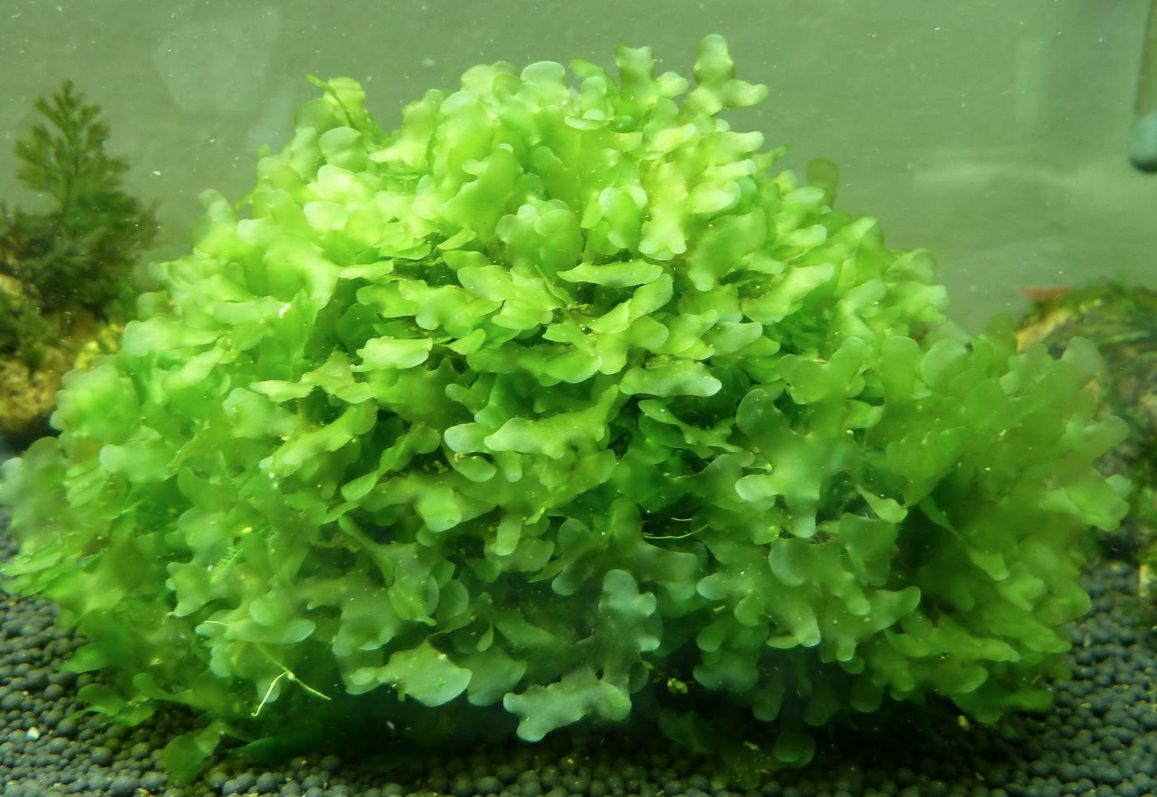
Leafless Subwassertang moss, in fact, is very much alike tenfold Riccia. However, Riccia is a floating plant, that’s why some efforts from an aquarist are required for it to grow successfully as a ground-covering plant in a tank.
Subwassertang is heavier than water and that’s why it always stays on a tank bottom, it’s not demanding in terms of keeping and as soon as its starts to grow, it will spread all over the tank forming rather good-looking green ‘pillows’ on the tank bottom.
The plant feels fine at quite wide temperature range. Subwassertang moss can grow both in a shadow and at bright light, in hard and soft water. Provided with less favorable conditions moss grows longer (up to 3 cm), it has narrow furca (up to 5 mm) and looks less decorative.
On the bottom of the moss structure there are rhizoids by means of which the moss sticks to stones or snags.
| Aspect | Description |
|---|---|
| Scientific Name | Lomariopsis sp. |
| Appearance | Free-shaped plant with fine branching structures and dark green or brownish coloration |
| Growth Rate | Slow to moderate growth rate |
| Light Requirements | Can tolerate low to moderate lighting conditions |
| CO2 Requirement | Can thrive without CO2 supplementation |
| Water Parameters | Temperature: 68-82°F (20-28°C); pH: 6.0-7.5; soft to moderately hard water |
| Attachment | Can be attached to rocks or driftwood, or left to float freely in the aquarium |
| Maintenance Level | Low-maintenance plant; occasional cleaning and trimming required |
| Propagation Methods | Reproduces by fragmentation or spore formation |
| Versatility | Suitable for aquariums, terrariums, and paludariums |
| Benefits | Provides shelter and grazing areas for small fish and invertebrates |
| Common Uses | Aquascaping, attaching to hardscape, or creating a natural and wild look |
Riccia fluitans
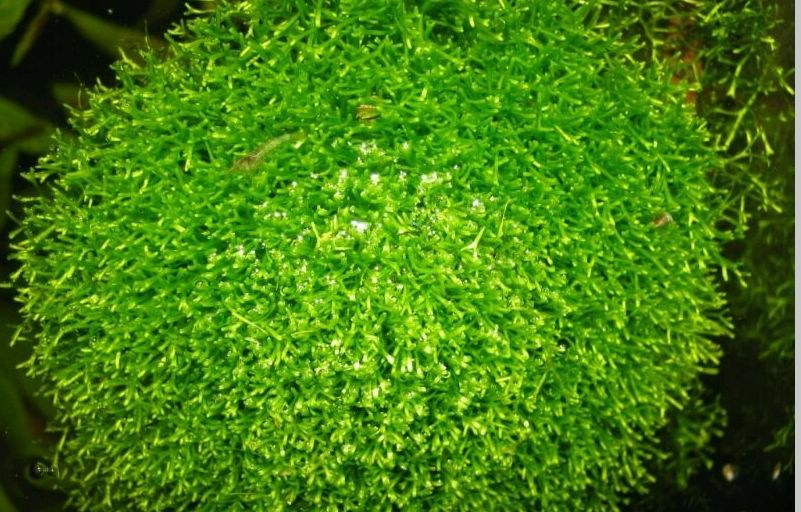
Floating crystalwort is widely spread in Europe, Asia, Africa and South America. This is a good-looking plant that consists of bright-green balls of various sizes. It floats on the water surface.
Riccia is often used as a ground-covering plant in a tank. To do this, take a bunch of riccia, cover it with a mesh and pin it against a stone.
It will grow intensively and its shoots will close the mesh in time. The stone with the moss bunch tied to it will turn into a fluffy bright-green hillock, which together with others form a green carpet on the tank bottom covered with small silvery oxygen bubbles.
Riccia requires bright vertical light. It easily stands temperature variations. It grows better in soft water with neutral or weakly alkaline reaction. At water hardness higher than 8° Riccia grows poorer. The plant reproduces very fast and covers all water surface with solid green carpet.
| Aspect | Description |
|---|---|
| Scientific Name | Riccia fluitans |
| Appearance | Floating moss-like plant with branching, hair-like strands forming a dense, carpet-like structure |
| Growth Rate | Fast growth rate, suitable for low to high-tech setups |
| Light Requirements | Thrives under moderate to high lighting conditions |
| CO2 Requirement | Can grow well without CO2 supplementation, but benefits from CO2 injection for faster growth |
| Water Parameters | Temperature: 64-86°F (18-30°C); pH: 6.0-8.0; soft to hard water |
| Attachment | Typically floats freely in the water or can be anchored to hardscape with fishing line or mesh |
| Maintenance Level | Moderate-maintenance plant; regular trimming to prevent overgrowth and maintain desired shape |
| Propagation Methods | Easily propagated by dividing the carpet-like structure into smaller portions |
| Versatility | Suitable for aquariums, paludariums, and emersed setups; provides hiding spots for small species |
| Benefits | Enhances water quality by absorbing excess nutrients, provides shelter for fry and small fish |
| Common Uses | Aquascaping, creating a natural carpeting effect, providing cover for aquatic inhabitants |
Willow moss (Fontinalis antipyretica)
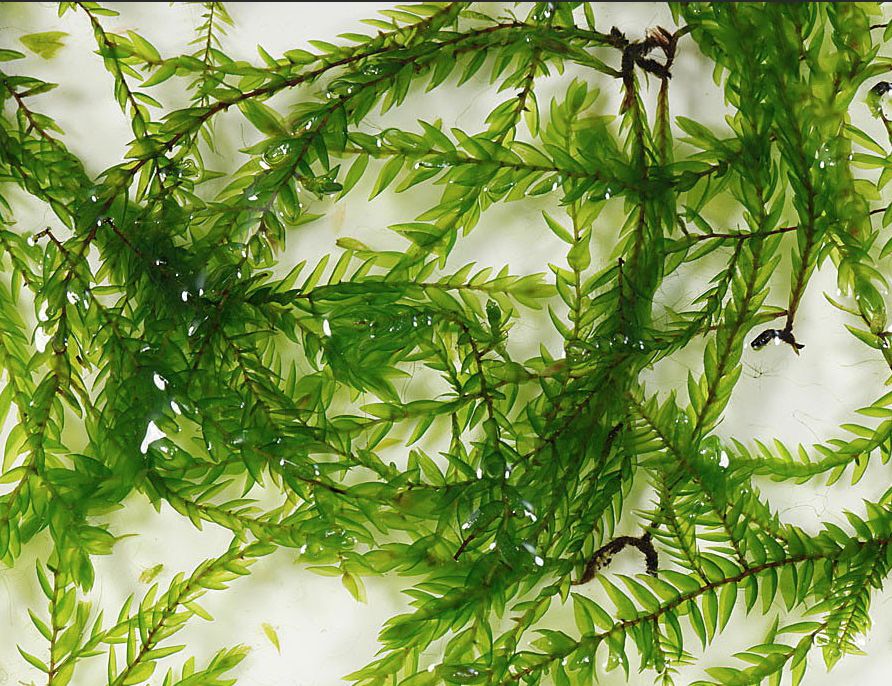
Willow Moss (Fontinalis antipyretica) is a very spectacular and good-looking plant that grows almost on all Earth continents except Australia. Though mosses are not aquatic plants, quite often their habitat is in streams, rivers, lakes, small bogs due to their incredible ability to adapt to changing living conditions.
Willow moss grows in large groups forming gorgeous laced vegetation that delicately decorates the tank. Its branched shoots rising upwards can grow up to 60 cm long provided with favorable conditions. On round or faceted stems of the moss there small oval sharpened leaves about 1 cm long and 0.5 cm wide. Depending on growth conditions Willow moss can change its size and lamina shape as well as its coloring – it may vary from red-brown to bright-green.
Since Willow moss has no roots, it doesn’t require a substrate; so it is quite ok both when floating in the tank water and sticking with its rhizoids to some objects. To make the moss stick to some place, it is enough to pin it against a coarse or porous surface and not to disturb it for 2-3 month.
Willow moss grows seasonally and this is the main reason of all failures that happen when growing this plant in a tank. In summer you can keep it at water temperature from 24 to 28 0 C. In winter the plant needs a dormant period, that’s why the water temperature should be decreased to 10-12 0 C.
If you leave Willow moss for the winter in a tank without heating, where the water has a room temperature, the plant won’t live long – it will survive winter and die the next autumn.
That’s why it is recommended to put Willow moss into some other volume for the winter and to provide it with growing conditions similar to those in the wild; then put the volume into the room with air temperature lower than 100C.
Tank lighting should be scattered and not very bright. If there is too much light, algae may appear on the moss stem and leaves, which leads to the death of the plant.
You should cover Willow moss from direct sun light by putting it in the shadow of tall or floating tank plants; and light day duration for the moss should be limited to 10 hours.
| Aspect | Description |
|---|---|
| Scientific Name | Fontinalis antipyretica |
| Appearance | Feathery moss with long, slender branches resembling willow leaves |
| Growth Rate | Moderate growth rate, suitable for low to high-tech setups |
| Light Requirements | Thrives under moderate to high lighting conditions |
| CO2 Requirement | Can grow well without CO2 supplementation, but benefits from CO2 injection for faster growth |
| Water Parameters | Temperature: 55-77°F (13-25°C); pH: 5.0-8.0; soft to moderately hard water |
| Attachment | Attaches to various surfaces like rocks, driftwood, and aquarium decorations |
| Maintenance Level | Low-maintenance plant; occasional trimming to maintain shape and prevent overgrowth |
| Propagation Methods | Easily propagated by cutting and reattaching sections of the moss |
| Versatility | Suitable for aquariums, terrariums, and paludariums; provides hiding spots for small aquatic species |
| Benefits | Enhances water quality by absorbing excess nutrients and provides shelter for fry and small fish |
| Common Uses | Aquascaping, creating a natural and flowing appearance, attaching to hardscape for a unique look |
Taiwan Moss (Taxiphyllum alternans)
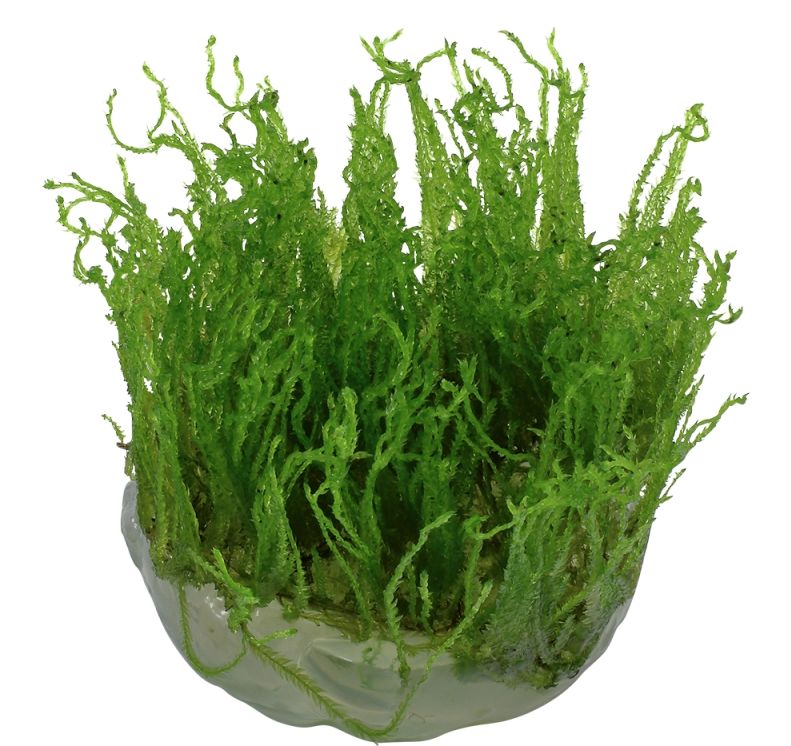
Taiwan Moss is a decorative aquarium moss brought from Taiwan. Its shoots have triangle shape, under water they become curved. The moss bunch looks very tiny, but in time its brunches may become quite large.
The plant is rather undemanding and easy to keep. It grows slowly and gradually forms bright, juicy, green, exuberant bushes. Taiwan moss growth rate is a medium one; it easily sticks to a substrate and it is easy to keep and care. Sometimes pet shops sell it as a Mini Moss, it looks quite similar to Weeping mosss.
Comfortable water parameters are the following: tank water temperature from 15 to 28 °C, kH from 2 to 14°, pH from 5 to 8. The plant prefers soft water and sufficient lighting.
Without bright illumination the moss changes its color and its growth rate decreases; if the tank lighting isn’t sufficient, the moss grows slower, chaotically and less thickly.
| Aspect | Description |
|---|---|
| Scientific Name | Taxiphyllum alternans |
| Appearance | Delicate, branching moss with small, triangular-shaped leaves |
| Growth Rate | Slow to moderate growth rate, suitable for low to high-tech setups |
| Light Requirements | Thrives under moderate to high lighting conditions |
| CO2 Requirement | Can grow well without CO2 supplementation, but benefits from CO2 injection for faster growth |
| Water Parameters | Temperature: 68-82°F (20-28°C); pH: 6.0-7.5; soft to moderately hard water |
| Attachment | Attaches to various surfaces like rocks, driftwood, and aquarium decorations |
| Maintenance Level | Low-maintenance plant; occasional trimming to maintain shape and prevent overgrowth |
| Propagation Methods | Easily propagated by cutting and reattaching sections of the moss |
| Versatility | Suitable for aquariums, terrariums, and paludariums; provides hiding spots for small aquatic species |
| Benefits | Enhances water quality by absorbing excess nutrients and provides shelter for fry and small fish |
| Common Uses | Aquascaping, creating a natural and lush appearance, attaching to hardscape for a unique look |
Spiky Moss (Taxiphyllum sp ‘Spiky Moss’)
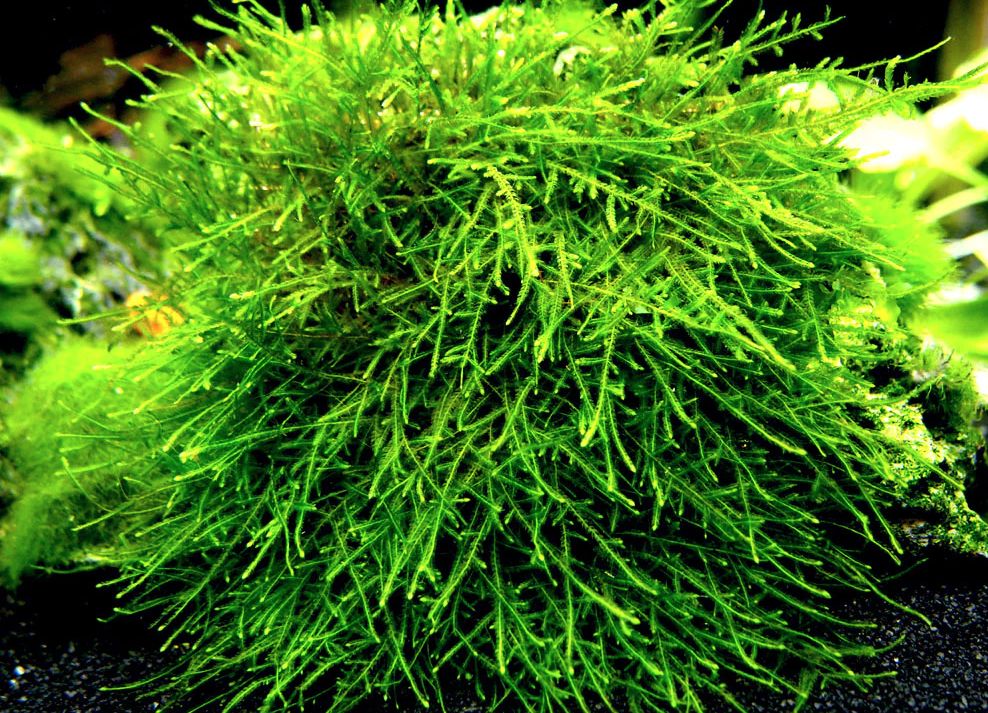
Spiky Moss (Taxiphyllum spiky) is a type of aquatic moss with a distinct spiky or feathery appearance. It is a relatively new and less common moss species in the aquarium hobby. Spiky Moss is known for its distinctive appearance and can add an interesting texture and visual appeal to aquascapes. It can be used to create unique backgrounds, attached to hardscape elements, or simply allowed to float freely in the aquarium. Like other mosses, it provides shelter for small aquatic creatures and helps maintain water quality by absorbing excess nutrients.
| Aspect | Description |
|---|---|
| Scientific Name | Taxiphyllum spiky |
| Appearance | Moss with long, slender branches that form spiky or feathery clusters |
| Growth Rate | Moderate growth rate |
| Light Requirements | Thrives under moderate to high lighting conditions |
| CO2 Requirement | Can grow well without CO2 supplementation, but benefits from CO2 injection for faster growth |
| Water Parameters | Temperature: 68-82°F (20-28°C); pH: 6.0-7.5; soft to moderately hard water |
| Attachment | Attaches to various surfaces like rocks, driftwood, and aquarium decorations |
| Maintenance Level | Low-maintenance plant; occasional trimming to maintain shape and prevent overgrowth |
| Propagation Methods | Easily propagated by cutting and reattaching sections of the moss |
| Versatility | Suitable for aquariums, terrariums, and paludariums; provides hiding spots for small aquatic species |
| Benefits | Enhances water quality by absorbing excess nutrients and provides shelter for fry and small fish |
| Common Uses | Aquascaping, creating unique and textured backgrounds or attaching to hardscape for a spiky look |
Riccardia chamedryfolia
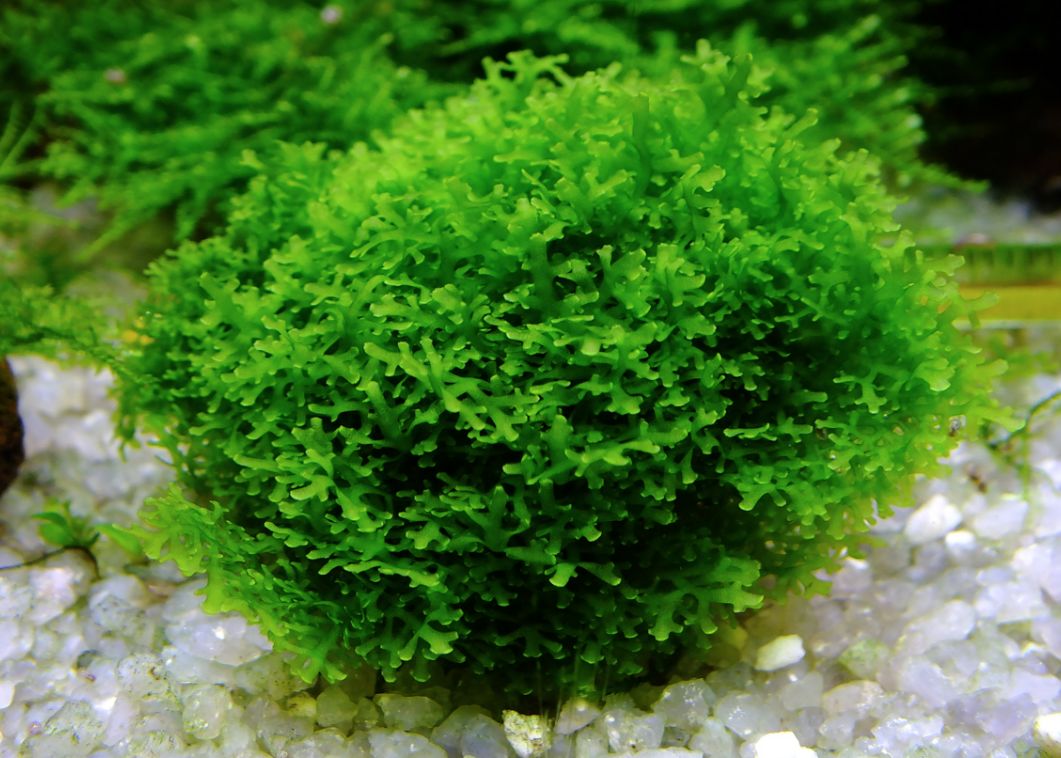
Riccardia chamedryfolia, commonly known as Mini Pellia or Coral Moss, is a unique and beautiful moss-like aquatic plant. Riccardia chamedryfolia features small, flat thalli that resemble liverworts. It has a vibrant green color and a delicate, lace-like appearance, which adds an attractive texture to aquascapes.
Moderate to high lighting is recommended for Riccardia chamedryfolia. Sufficient light promotes healthy growth and helps maintain its vibrant green coloration.
Riccardia chamedryfolia propagates through fragmentation. You can divide the plant into smaller portions and attach them to desired surfaces using fishing line, glue, or mesh. Over time, the divided portions will grow and spread to form new mats.
| Aspect | Riccardia chamedryfolia |
|---|---|
| Common Names | Mini Pellia, Coral Moss |
| Appearance | Small, flat thalli with lace-like texture |
| Growth Habit | Creeping moss, forms dense carpets or mats |
| Maximum Height | Up to 1 inch (2.5 cm) |
| Lighting Requirements | Moderate to high |
| CO2 Requirement | Optional, but beneficial |
| Water Temperature | 68-82°F (20-28°C) |
| pH Range | 6.0-7.5 |
| Water Hardness | Tolerates a wide range |
| Propagation Method | Fragmentation |
| Ideal Placement | Attached to rocks, driftwood, or mesh |
| Suitable for Small Tanks | Yes |
| Ideal for Low-Tech Setups | No |
| Commonly Available | Yes |
Keeping in a tank
Most of aquarium moss kinds are rather undemanding plants. They easily adapt to new tank water parameters and conditions. At that typically they change their appearance. Mosses can change unrecognizably depending on tank conditions.
Aquarium mosses grow better if they are attached to various substrates. These may be stones, different decorations, coconut shells, snags. It is completely up to you which substrate to choose.
When growing mosses you should be patient and shouldn’t disturb them often. All mosses need some time for adaptation, especially if their previous tank conditions varied greatly from the current ones. This may take from several days to several weeks and sometimes even months.
Water filtration is of crucial importance in a tank with mosses. Floating rubbish or coarse dispersion present in the tank water have negative impact on development process of small and delicate mosses.
Thoughtfully organized tank water circulation which ensures no quiescent areas appearance also shouldn’t disturb the mosses with strong water flow. Therefore, a small internal water filter is enough for this purpose.
Tank water shouldn’t contain any suspended matter which can settle on mosses and this way slow down or even stop their development. That’s why it’s not recommended to keep extremely active, herbivorous, large and bottom digging fishes in such a tank.
You also won’t need a heater for this tank. It is more likely that you will need a cooling system for hot seasons. It is desirable that tank water temperature doesn’t exceed 25 °C (77°F). At higher temperatures mosses feel quite poor (Fontinalis moss is especially sensitive) and provided with such tank conditions for sufficiently long period of time they can even die.
Tank water hardness isn’t of great importance, but according to some data mosses demonstrate their best pace of growth and appearance in water with medium hardness.
It is likely to be due to the species living conditions in the wild. Weekly water renew is a must for them.
Tank bottom substrate in a tank with mosses should be chemical-resistant. You definitely won’t need quartz chips and other dyed bottom substrates as well as coral sand, since they will increase tank water hardness or add metal ions into it. You should clean tank bottom with a siphon regularly to avoid silting.
There is an erroneous belief that most of mosses don’t require bright tank illumination to grow successfully. This is true to a certain degree only for some moss kinds. If you intend to see nice and healthy plants in your tank it’s desirable to use directional light. It should successfully pass the water column to the bottom. It is a good practice to add CO2 supply to ensure intensive vegetation of your tank plants.
Care
Main things you should do to take care of the moss is cutting it and removing rubbish from it. When cleaning the tank with a siphon don’t forget about the moss. Just waggle the siphon near it to make sure that the settled rubbish goes up and the siphon sucks it in.
You should be very careful, since not all mosses attach to the substrate strongly and you may accidentally tear the whole bunch from its substrate.
Therefore, you may also take the substrate with moss on it from the tank and wash it separately and then just put it back where it was.
Cutting moss is of high importance not only to make the moss look good. The thing is, that when the moss grows and becomes thick it stops light penetration to its bottom levels, this is why cutting it timely is a crucial thing to do.
Friends of aquarium mosses
Various kinds of small shrimps (such as cherry shrimp etc.) are considered to be the most helpful tankmates for aquarium mosses. These small creatures feed on moss bushes all the time, they search moss shoots with their chelae and collect the rubbish.
Amano shrimp (Caridina multidentata) is one of the best to fight against green hair algae, which is very dangerous for all mosses (sometimes it becomes possible to get rid of this algae only when taking the moss overwater).
Japanese algae eating shrimp just eats the algae and doesn’t allow it to grow. However, there were the cases when hungry Amano shrimp damaged mosses as well.
When buying a moss, especially an expensive one, don’t forget to check it for having any surprises inside (such as algae, eggs etc.). To do this, put it on a white plate turn a desk lamp on and take a closer look at the moss using pincers.
Enemies of aquarium mosses
Actually, there aren’t many. Algae is their main enemy. It either dwells on a moss and destroys its appearance and nutrition process, or it grows among the moss shoots and makes it look as an ugly ball of something.
Moss has almost no enemies among fishes. Though it can be nipped by some large ones like cichlids, but small and medium sized fish species don’t do it as a rule.
However, Siamese algae eater this is the fish who really loves eating mosses. For it moss is a delicacy and that’s why any kind of moss will be eaten by the root. The only kind of moss they don’t eat is Phoenix moss.
Decorations and how to attach moss
It is a good practice to attach mosses that mostly grow upwards or sideward to stones or short snags, while those that grow downwards look better if you put them somewhere on top (for example, Weeping Moss).
As a rule, mosses are attached to any kinds of hard species of wood (mangrove, argan tree, grape-vine, roots of fruit trees etc.).
There is no critical difference in using any of these materials. However, you should prepare the snags in advance before putting them in a tank. It will be good if you wash them thoroughly and then boil for several hours.
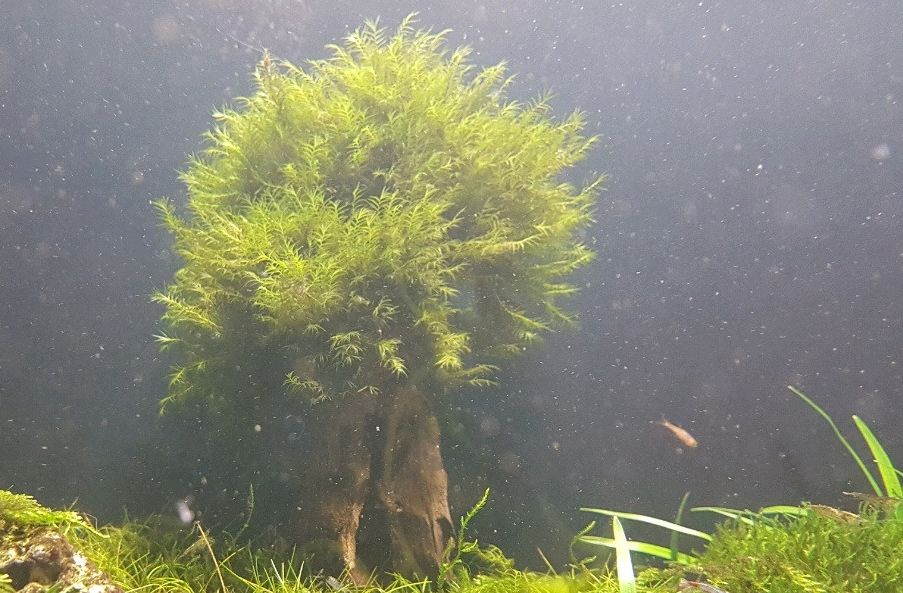
Lava and tuff are also good substrates to attach a moss. It is enough just to wash them with tap water; they don’t require any additional cleaning. Pieces of ceramic flower pots, coconut shells and other nonpoisonous materials will do as well.
Some moss kinds can’t attach to any substrate at all. It is recommended to place thin layer of moss on decorations and exclude, if possible, overlapping of the moss shoots with each other; then tie them with a sea-line to the substrate. This is the most reliable way of attaching the moss.
As the moss grows, its new shoots cover the sea-line and it won’t be visible at all. You can also use cotton thread to tie moss (if you know in advance that it will grow on the substrate). In time the thread won’t be seen under the moss bush and then it will just rot, but the moss will tightly stick to the substrate, so you won’t have to cut the thread.
These are kinds of moss that grow and stick to the substrate – Phoenix Moss, Flame Moss, Riccardia graeffei, Bubble moss, Triangle Moss. However, there were reported cases when catfishes ground up the thread before the moss had a chance to stick to the substrate.
Another way of attaching mosses that grow and stick to the substrate is using a usual ‘super glue’. This approach is good for ultra small peaces of moss or applicable where it’s not convenient to use a sea-line or a thread; for example, on large snags.
It’s better to use cyanoacrylate glue, since after it dries, it’s completely not toxic for tank dwellers.